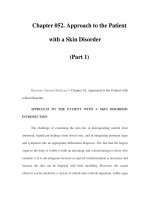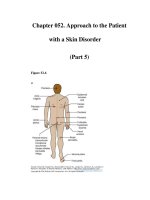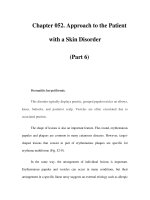Chapter 077. Approach to the Patient with Cancer (Part 7) ppt
Bạn đang xem bản rút gọn của tài liệu. Xem và tải ngay bản đầy đủ của tài liệu tại đây (11.67 KB, 5 trang )
Chapter 077. Approach to the
Patient with Cancer
(Part 7)
The recognition and treatment of depression are important components of
management. The incidence of depression in cancer patients is ~25% overall and
may be greater in patients with greater debility. This diagnosis is likely in a patient
with a depressed mood (dysphoria) and/or a loss of interest in pleasure
(anhedonia) for at least 2 weeks. In addition, three or more of the following
symptoms are usually present: appetite change, sleep problems, psychomotor
retardation or agitation, fatigue, feelings of guilt or worthlessness, inability to
concentrate, and suicidal ideation. Patients with these symptoms should receive
therapy. Medical therapy with a serotonin reuptake inhibitor such as fluoxetine
(10–20 mg/d), sertraline (50–150 mg/d), or paroxetine (10–20 mg/d) or a tricyclic
antidepressant such as amitriptyline (50–100 mg/d) or desipramine (75–150 mg/d)
should be tried, allowing 4–6 weeks for response. Effective therapy should be
continued at least 6 months after resolution of symptoms. If therapy is
unsuccessful, other classes of antidepressants may be used. In addition to
medication, psychosocial interventions such as support groups, psychotherapy,
and guided imagery may be of benefit.
Many patients opt for unproven or unsound approaches to treatment when it
appears that conventional medicine is unlikely to be curative. Those seeking such
alternatives are often well educated and may be early in the course of their disease.
Unsound approaches are usually hawked on the basis of unsubstantiated anecdotes
and not only cannot help the patient but may be harmful. Physicians should strive
to keep communications open and nonjudgmental, so that patients are more likely
to discuss with the physician what they are actually doing. The appearance of
unexpected toxicity may be an indication that a supplemental therapy is being
taken.
3
3
Information about unsound methods may be obtained from the National
Council Against Health Fraud, Box 1276, Loma Linda, CA 92354, or from the
Center for Medical Consumers and Health Care Information, 237 Thompson
Street, New York, NY 10012.
Long-Term Follow-Up/Late Complications
At the completion of treatment, sites originally involved with tumor are
reassessed, usually by radiography or imaging techniques, and any persistent
abnormality is biopsied. If disease persists, the multidisciplinary team discusses a
new salvage treatment plan. If the patient has been rendered disease-free by the
original treatment, the patient is followed regularly for disease recurrence. The
optimal guidelines for follow-up care are not known. For many years, a routine
practice has been to follow the patient monthly for 6–12 months, then every other
month for a year, every 3 months for a year, every 4 months for a year, every 6
months for a year, and then annually. At each visit, a battery of laboratory and
radiographic and imaging tests were obtained on the assumption that it is best to
detect recurrent disease before it becomes symptomatic. However, where follow-
up procedures have been examined, this assumption has been found to be untrue.
Studies of breast cancer, melanoma, lung cancer, colon cancer, and lymphoma
have all failed to support the notion that asymptomatic relapses are more readily
cured by salvage therapy than symptomatic relapses. In view of the enormous cost
of a full battery of diagnostic tests and their manifest lack of impact on survival,
new guidelines are emerging for less frequent follow-up visits, during which the
history and physical examination are the major investigations performed.
As time passes, the likelihood of recurrence of the primary cancer
diminishes. For many types of cancer, survival for 5 years without recurrence is
tantamount to cure. However, important medical problems can occur in patients
treated for cancer and must be examined (Chap. e13). Some problems emerge as a
consequence of the disease and some as a consequence of the treatment. An
understanding of these disease- and treatment-related problems may help in their
detection and management.
Despite these concerns, most patients who are cured of cancer return to
normal lives.
Supportive Care
In many ways, the success of cancer therapy depends on the success of the
supportive care. Failure to control the symptoms of cancer and its treatment may
lead patients to abandon curative therapy. Of equal importance, supportive care is
a major determinant of quality of life. Even when life cannot be prolonged, the
physician must strive to preserve its quality. Quality-of-life measurements have
become common endpoints of clinical research studies. Furthermore, palliative
care has been shown to be cost-effective when approached in an organized
fashion. A credo for oncology could be to cure sometimes, to extend life often,
and to comfort always.









